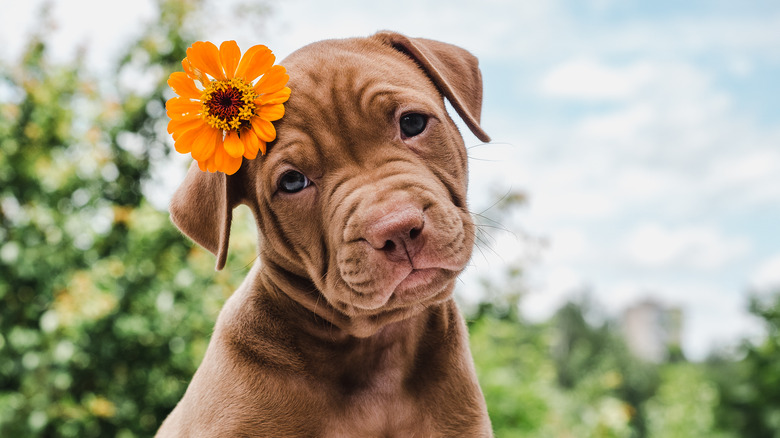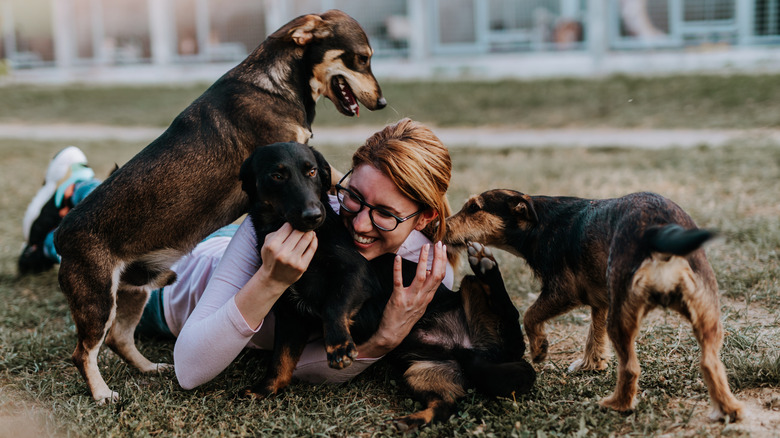Science Says This Is When Puppies Reach Peak Cuteness
According to The Washington Post, today, roughly 85% of dogs in the world live on the street. The life of a stray may have its benefits, suggest Ray and Lorna Coppinger, authors of "What Is a Dog?" They say that a dog living on the streets in Nairobi has an overall better quality of life than a domesticated dog living in Beverly Hills (via Psychology Today). However, the survival rate for puppies living on the street is grim.
Unlike wolves, which wean their young after two years full of nurturing and lessons in survival, dogs leave their young after two months, reports The Washington Post. Young pups on the street are left to fend for themselves, leading to 80% of stray puppies dying before the age of 1 (per Psychology Today). Finding a human to provide care becomes essential for puppies on their own and could mean the difference between life or death.
For those looking to help those vulnerable puppies, even in countries without high rates of strays, donating to organizations that provide on-the-ground healthcare, clinics, and veterinary training can be helpful. Top Dog Tips publishes an annual list of the world's top dog rescue organizations. Their 2021 list suggests Compassion Without Borders, Rudozem Street Dog Rescue in Bulgaria, or Thailand's Soi Dog Foundation. Ready to give a street pup a home? The Centers for Disease Control and Prevention encourages adopters to educate themselves about avoiding scams, disease prevention, and dog import permits before they begin the process.
Do puppies need humans?
The good news is, nothing seems to cure a bad mood better than cute puppies. Some colleges and universities even bring puppies and therapy dogs to their campuses during finals week to relieve student stress (via UConn and Affordable Colleges Online). This cuteness is strategic, says a 2018 study led by Arizona State University's Clive Wynne, professor of psychology and director of the school's Canine Science Laboratory (per ASU News).
According to Wynne and his team, dogs reach their peak cuteness to humans right around the time their mothers wean them — just about eight weeks. He explains, "Around seven or eight weeks of age, just as their mother is getting sick of them and is going to kick them out of the den and they're going to have to make their own way in life, at that age, that is exactly when they are most attractive to human beings." At their most vulnerable, puppies become their most desirable to humans.
Wynne's findings don't mean that puppies stop being cute as they age or that we love them any less as they get older. Wynne clarifies that "[The study] doesn't mean to say that we stop loving our dogs past [eight weeks]. ... The eight-week point is just the point where the hook is biggest, the ability of the animal to grab our interest is strongest. But, having grabbed our interest, we continue to love them all their lives" (via ASU News).
How to find peak cuteness
After spending time in the Bahamas and observing street dogs, researcher Clive Wynne wondered how dogs overcame their early-age vulnerability. He brought his question back to the Canine Science Laboratory at Arizona State University and got to work (ASU News). Wynne began with the guess that dogs would reach their peak attractiveness to humans when their mothers stop providing care and when they are the most vulnerable (per Anthrozoös posted by Taylor & Francis Online). Wynne's team showed 51 participants photos of various puppies from birth to 7 months to test this theory. The study included three breeds: Jack Russell Terrier, Cane Corso, and White Shepherd.
The study confirmed Wynne's guess. Participants found Jack Russell Terriers to be the cutest at 7.7 weeks, Canine Corsos at 6.3 weeks, and White Shepherds at 8.3 weeks, seeming to show that Wynne was right (per Anthrozoös). Of course, there's always room for further discovery. Wynne told ASU News that he'd like to use video of puppies in follow-up studies to determine whether body language and movement also contribute to cuteness. Additionally, he'd like to perform a similar study on puppy mothers.
What remains clear is that the love between humans and dogs is mutual. According to The Atlantic, studies have shown that when a dog looks into a human's eyes, both receive a surge of oxytocin, the love hormone.


